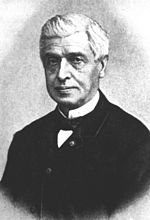Gabriel Auguste Daubrée
| Gabriel Auguste Daubrée | |
|---|---|

Gabriel Auguste Daubrée
|
|
| Born | June 25, 1814 Metz |
| Died |
May 29, 1896 (aged 81) Paris 7ème |
| Nationality | French |
| Fields | geology |
| Alma mater | École Polytechnique |
| Notable awards | Wollaston Medal (1880) |
Gabriel Auguste Daubrée MIF FRS FRSE (June 25, 1814 – May 29, 1896) was a French geologist.
Daubrée was born at Metz, and educated at the École Polytechnique in Paris.
At the age of twenty he had qualified as a mining engineer, and in 1838 he was appointed to take charge of the mines in the Bas-Rhin (Alsace), and subsequently to be professor of mineralogy and geology at the Faculty of Sciences, Strasbourg. In 1859 he became engineer in chief of mines, and in 1861, upon the death of Louis Cordier, he was appointed professor of geology at the Museum d'Histoire Naturelle in Paris and was also elected member of the French Academy of Sciences. In the following year he became professor of mineralogy at the École des Mines, and in 1872 director of that school. In 1878 Daubrée was elected vice-president and in 1879 president of the French Academy of Sciences. In 1880 the Geological Society of London awarded to him the Wollaston medal. In 1881 he was promoted to Grand Officer of the French Legion of Honour.
His published researches date from 1841, when the origin of certain tin minerals attracted his attention; he subsequently discussed the formation of bog-iron ore, and worked out in detail the geology of the Bas-Rhin (1852). From 1857 to 1861, while engaged in engineering works connected with the springs of Plombieres, he made a series of interesting observations on thermal waters and their influence on the Roman masonry through which they made their exit. He was, however, especially distinguished for his long-continued and often dangerous experiments on the artificial production of minerals and rocks. He likewise discussed the permeability of rocks by water, and the effects of such infiltration in producing volcanic phenomena; he dealt with the subject of metamorphism, with the deformations of the Earth's crust, with earthquakes, and with the composition and classification of meteorites.
...
Wikipedia
